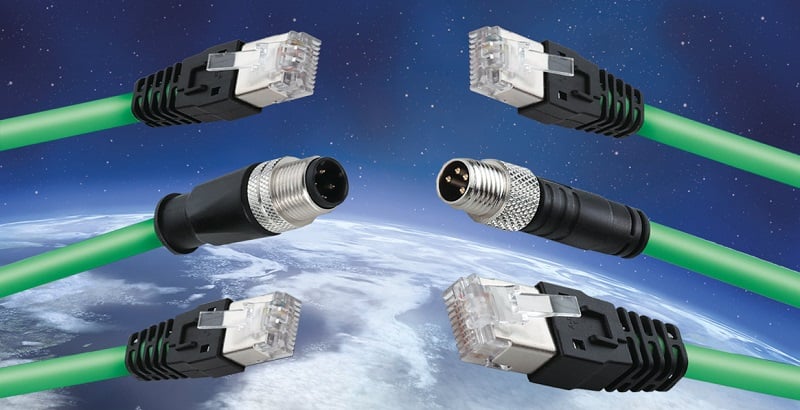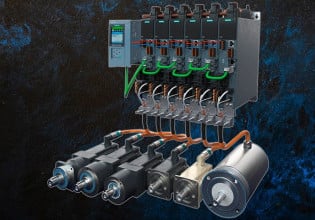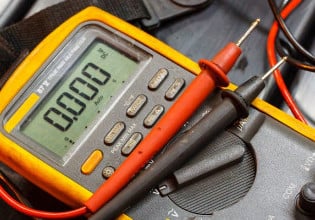Comparing Industrial Ethernet Protocols
This article reviews and compares some of the most prominent industrial Ethernet protocols.
Ethernet is a physical layer connection, widely considered the standard in modern internet communications. In this scope, it works together with the TCP/IP protocol (Transmission Control Protocol / Internet Protocol). TCP/IP consists of specifications at the transport and network layers that determine how information is transmitted and interpreted over Ethernet. TCP/IP is based on a client/server model where a server computer provides services to a client computer. These services can be requests for information, files and connection parameters, or access to websites.

Figure 1. The internet is founded on the client/server model introduced by TCP/IP. Image used courtesy of Akinnovate
Introduction to TCP/IP Standard
TCP/IP is not only the most popular protocol in internet communications, but it is also the first Ethernet-based protocol that was used in industrial systems. With the arrival of system controllers such as PLCs and increased vertical integration of control systems, the demand for near real-time communication grew rapidly. Already widely available in the personal computer world, Ethernet with TCP/IP came to meet the needs of higher speed and bandwidth in the industry.
However, TCP/IP presented a fundamental problem to control systems that became a major drawback from the start. TCP/IP is non-deterministic, meaning it is vulnerable to unpredictable delays and transmission failures. When an issue occurs, a commercial TCP/IP network waits a random amount of time before the next data transmission is attempted. This does not work in control systems where determinism is essential as it guarantees reliability. It means that data transmissions are expected within a known amount of time, not more and not less. Determinism is a requirement in control systems because these systems directly affect productivity and performance. There is also a safety component involved when safety devices are expected to respond within a certain time.
Industrial Ethernet protocols were developed to solve the problem of determinism. They provide the same real-time communication as TCP/IP while simultaneously guaranteeing reliable communication between controllers. The next sections of this article describe and compare some of the most well-known industrial Ethernet protocols in the industry.
Industrial Ethernet Basics
There are some basic characteristics that all industrial Ethernet protocols share. The first one is that, naturally, all are based on Ethernet hardware and thus share the physical and data link layers. Also, due to the harsh environmental conditions, industrial Ethernet components are designed differently from commercial ones. Cables and connectors are built with heavier locking mechanisms and are typically shielded to protect against noise and to enhance durability.

Figure 2. Industrial Ethernet cables and connectors are heavy-duty and resist harsh environments. Image used courtesy of Lutze
In terms of speed, data transmission rates range from 10 Mbps to 1 Gbps, with 100 Mbps being the most popular. Compared to commercial Ethernet, the speed needed is much lower because control and automation data bandwidth remain relatively low.
Industrial Ethernet protocols can connect devices via two main methods, wired or wireless. Wired Ethernet uses the standard RJ45 cable and connectors. Wired Ethernet comprises the majority of the world’s industrial network installed base and due to this, it is normally referred to as simply Ethernet. On the other hand, wireless Ethernet (rf-based Wi-Fi) has experienced initial difficulties entering the industrial market, but as reliability and security issues are addressed, it is predicted to gain more acceptance.
Nearly all major automation companies in the world rely heavily on industrial Ethernet protocols. Siemens, Rockwell Automation, Schneider Electric, and Beckhoff are just a few of these companies. The next section compares the protocols, along with examples of which companies use them to a great extent.
Comparison of Industrial Ethernet Protocols
- Siemens: PROFINET
PROFINET networks are generally faster than those of its competitors. Siemens offers a portfolio of PROFINET-ready devices that make it easy to replace or retrofit Siemens control systems. However, upgrades are less flexible when other brands are involved. On the other hand, PROFINET infrastructure is on average more costly than others. PROFINET networks are primarily deployed using line topology, which reduces the amount of cable needed, although tree and star topologies are also supported.

Figure 3. Official PROFINET logo
- Rockwell Automation: Ethernet/IP
Ethernet/IP is the more flexible and compatible protocol thanks to the use of off-the-shelf components and its object-oriented basis. It is also more cost-effective but slower than PROFINET. Ethernet/IP networks lean towards star topologies, but can often be found in ring and tree topologies to enhance redundancy.

Figure 4. Ethernet/IP logo. Image used courtesy of ABB
- Schneider Electric: Modbus TCP
Also known as Modbus TCP/IP, this protocol is an enhanced version of Modbus RTU with a TCP interface. Data is processed in the Modbus format, but it is wrapped and transmitted in Ethernet mode. A Modbus TCP network is normally programmed directly in the code of the controller using function blocks or other libraries, while PROFINET and Ethernet/IP are simply configured via a configuration tool.

Figure 5. Modbus logo. Image used courtesy of Modbus
- Beckhoff: EtherCAT
Instead of TCP/IP, this protocol employs a unique method of Ethernet communication in which a telegram traversing through the network can build upon itself after each node. At the end of the cycle, the telegram returns to the EtherCAT master. This makes communication very efficient as a message passes through each node only once. EtherCAT nodes can comply with determinism levels that are in the range of a few milliseconds. On the other hand, EtherCAT is not a flexible network because special EtherCAT-ready devices need to be implemented. Although EtherCAT devices are more costly on average, there are some cost savings in an overall network thanks to the reduced number of components needed. For instance, managed network switches are not needed.

Figure 6. EtherCAT logo. Image used courtesy of EtherCAT
Summary
Industrial Ethernet is the standard for modern communications, and while it is clear that many manufacturers are in a competition to design the most reliable, easily serviceable equipment, an understanding of these network systems is vital for any control technician or engineer.







Antonio Armenta obviously has never used Modbus TCP before. His statement is woefully incorrect. There is no code needed just configuration. For example, configuring the Modbus I/O table I put in the IP address of for example a TeSyS T Ethernet Motor Controller. Then I put the address that the control word comes from and the number of words that need to go to the TeSyS T. Then continuing on to read the items that are available from the TeSys T, You list the address of the table in the TeSyS T and then the address of where it is going. The communication portion is completed for this MCC bucket. You will still need code to turn on the required bits to make the motor run and to gather the desired data from the TeSys.